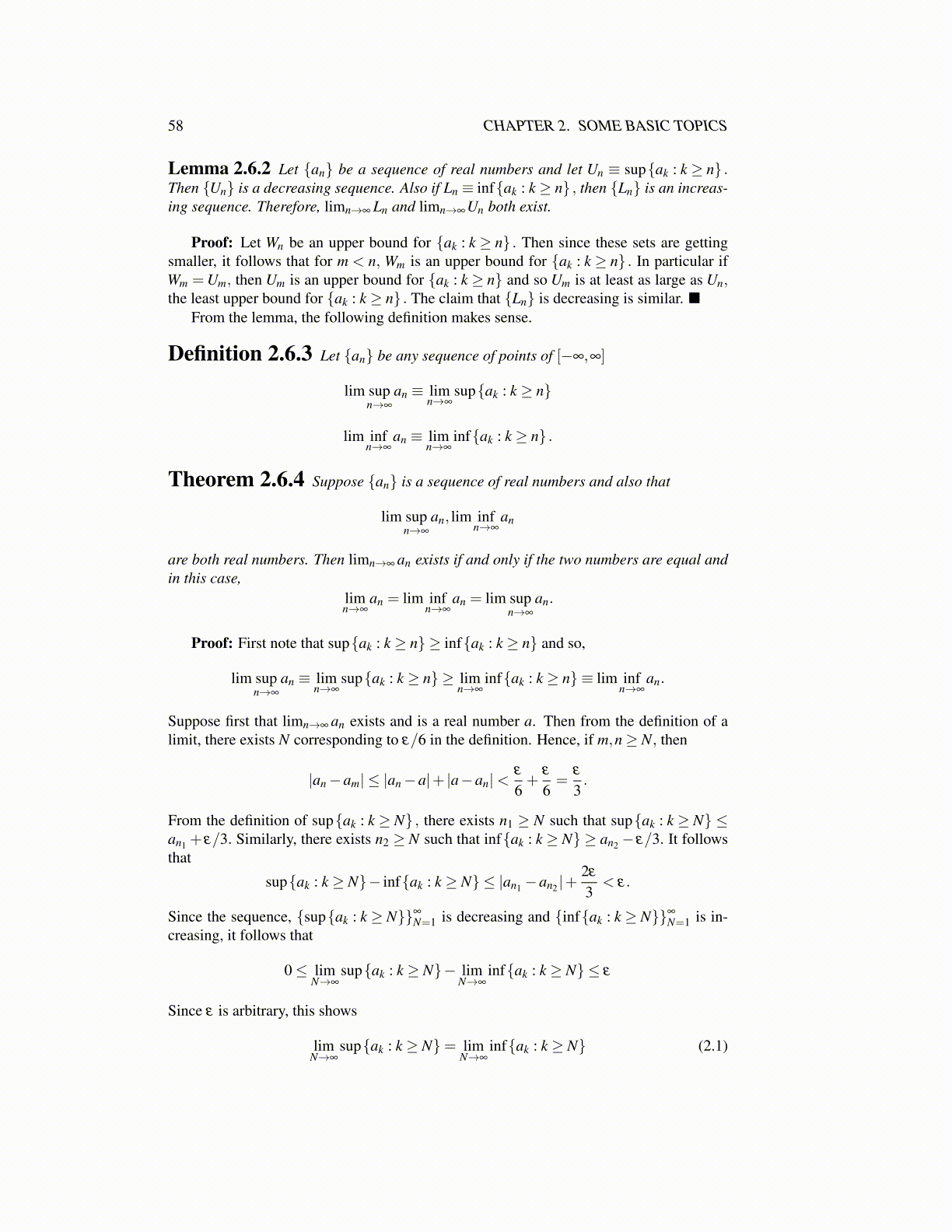
58 CHAPTER 2. SOME BASIC TOPICS
Lemma 2.6.2 Let {an} be a sequence of real numbers and let Un ≡ sup{ak : k ≥ n} .Then {Un} is a decreasing sequence. Also if Ln ≡ inf{ak : k ≥ n} , then {Ln} is an increas-ing sequence. Therefore, limn→∞ Ln and limn→∞ Un both exist.
Proof: Let Wn be an upper bound for {ak : k ≥ n} . Then since these sets are gettingsmaller, it follows that for m < n, Wm is an upper bound for {ak : k ≥ n} . In particular ifWm =Um, then Um is an upper bound for {ak : k ≥ n} and so Um is at least as large as Un,the least upper bound for {ak : k ≥ n} . The claim that {Ln} is decreasing is similar. ■
From the lemma, the following definition makes sense.
Definition 2.6.3 Let {an} be any sequence of points of [−∞,∞]
lim supn→∞
an ≡ limn→∞
sup{ak : k ≥ n}
lim infn→∞
an ≡ limn→∞
inf{ak : k ≥ n} .
Theorem 2.6.4 Suppose {an} is a sequence of real numbers and also that
lim supn→∞
an, lim infn→∞
an
are both real numbers. Then limn→∞ an exists if and only if the two numbers are equal andin this case,
limn→∞
an = lim infn→∞
an = lim supn→∞
an.
Proof: First note that sup{ak : k ≥ n} ≥ inf{ak : k ≥ n} and so,
lim supn→∞
an ≡ limn→∞
sup{ak : k ≥ n} ≥ limn→∞
inf{ak : k ≥ n} ≡ lim infn→∞
an.
Suppose first that limn→∞ an exists and is a real number a. Then from the definition of alimit, there exists N corresponding to ε/6 in the definition. Hence, if m,n≥ N, then
|an−am| ≤ |an−a|+ |a−an|<ε
6+
ε
6=
ε
3.
From the definition of sup{ak : k ≥ N} , there exists n1 ≥ N such that sup{ak : k ≥ N} ≤an1 + ε/3. Similarly, there exists n2 ≥ N such that inf{ak : k ≥ N} ≥ an2 − ε/3. It followsthat
sup{ak : k ≥ N}− inf{ak : k ≥ N} ≤ |an1 −an2 |+2ε
3< ε.
Since the sequence, {sup{ak : k ≥ N}}∞
N=1 is decreasing and {inf{ak : k ≥ N}}∞
N=1 is in-creasing, it follows that
0≤ limN→∞
sup{ak : k ≥ N}− limN→∞
inf{ak : k ≥ N} ≤ ε
Since ε is arbitrary, this shows
limN→∞
sup{ak : k ≥ N}= limN→∞
inf{ak : k ≥ N} (2.1)